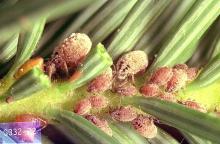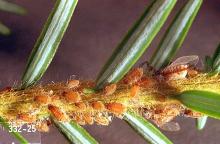Bow-legged fir aphid (Cinara curvipes)
Giant conifer aphid (Cinara spp.)
Pest description and damage This large (0.13 to 0.2 inch in length), brownish-black aphid congregates in large colonies on branches (especially the undersides). Aphids dropping onto underlying foliage or decks look somewhat like spiders. They secrete honeydew and promote sooty mold and their feeding can cause needles to turn yellow and drop prematurely resulting in defoliated branches. The aphids also produce copious honeydew, which attracts yellowjackets and other wasps. Black sooty mold may also develop on the honeydew, blocking light to the needles.
Biology and life history Eggs overwinter on needles and bark in the trees. The large black stem mothers hatch in early spring and give birth to young aphid nymphs that grow and soon begin giving birth to more aphids. Each stem mother produces live young that cluster in conspicuous aggregations of aphids among needles or on the undersides of larger branches. There may be multiple generations through the summer months.
For biology, life history, monitoring and management
See "Aphid" in:
Management-chemical control
See Table 1 in:


